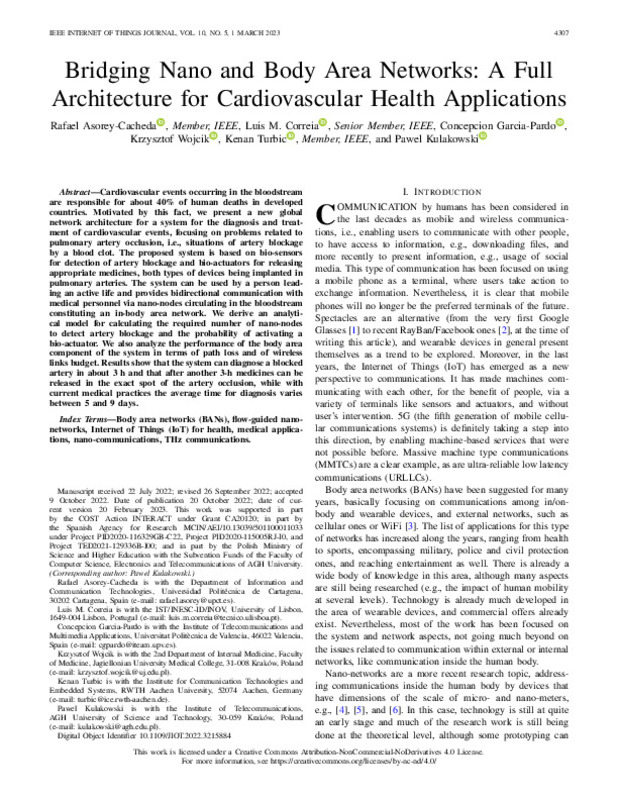JavaScript is disabled for your browser. Some features of this site may not work without it.
Buscar en RiuNet
Listar
Mi cuenta
Estadísticas
Ayuda RiuNet
Admin. UPV
Bridging Nano and Body Area Networks: A Full Architecture for Cardiovascular Health Applications
Mostrar el registro sencillo del ítem
Ficheros en el ítem
| dc.contributor.author | Asorey-Cacheda, Rafael
|
es_ES |
| dc.contributor.author | Correia, Luis M.
|
es_ES |
| dc.contributor.author | Garcia-Pardo, Concepcion
|
es_ES |
| dc.contributor.author | Wojcik, Krzysztof
|
es_ES |
| dc.contributor.author | Turbic, Kenan
|
es_ES |
| dc.contributor.author | Kulakowski, Pawel
|
es_ES |
| dc.date.accessioned | 2024-02-07T19:01:52Z | |
| dc.date.available | 2024-02-07T19:01:52Z | |
| dc.date.issued | 2023-03-01 | es_ES |
| dc.identifier.uri | http://hdl.handle.net/10251/202390 | |
| dc.description.abstract | [EN] Cardiovascular events occurring in the bloodstream are responsible for about 40% of human deaths in developed countries. Motivated by this fact, we present a new global network architecture for a system for the diagnosis and treatment of cardiovascular events, focusing on problems related to pulmonary artery occlusion, i.e., situations of artery blockage by a blood clot. The proposed system is based on bio-sensors for detection of artery blockage and bio-actuators for releasing appropriate medicines, both types of devices being implanted in pulmonary arteries. The system can be used by a person leading an active life and provides bidirectional communication with medical personnel via nano-nodes circulating in the bloodstream constituting an in-body area network. We derive an analytical model for calculating the required number of nano-nodes to detect artery blockage and the probability of activating a bio-actuator. We also analyze the performance of the body area component of the system in terms of path loss and of wireless links budget. Results show that the system can diagnose a blocked artery in about 3 h and that after another 3-h medicines can be released in the exact spot of the artery occlusion, while with current medical practices the average time for diagnosis varies between 5 and 9 days. | es_ES |
| dc.description.sponsorship | This work was supported in part by the COST Action INTERACT under Grant CA20120; in part by the Spanish Agency for Research MCIN/AEI/10.13039/501100011033 under Project PID2020-116329GB-C22, Project PID2020-115005RJ-I0, and Project TED2021-129336B-I00; and in part by the Polish Ministry of Science and Higher Education with the Subvention Funds of the Faculty of Computer Science, Electronics and Telecommunications of AGH University. | es_ES |
| dc.language | Inglés | es_ES |
| dc.publisher | Institute of Electrical and Electronics Engineers | es_ES |
| dc.relation.ispartof | IEEE Internet of Things | es_ES |
| dc.rights | Reconocimiento - No comercial - Sin obra derivada (by-nc-nd) | es_ES |
| dc.subject | Arteries | es_ES |
| dc.subject | Medical diagnostic imaging | es_ES |
| dc.subject | Lung | es_ES |
| dc.subject | Internet of Things | es_ES |
| dc.subject | Wearable computers | es_ES |
| dc.subject | Sensors | es_ES |
| dc.subject | Network architecture | es_ES |
| dc.subject | Body area networks (BANs) | es_ES |
| dc.subject | Flow-guided nano-networks | es_ES |
| dc.subject | Internet of Things (IoT) for health | es_ES |
| dc.subject | Medical applications | es_ES |
| dc.subject | Nano-communications | es_ES |
| dc.subject | THz communications | es_ES |
| dc.title | Bridging Nano and Body Area Networks: A Full Architecture for Cardiovascular Health Applications | es_ES |
| dc.type | Artículo | es_ES |
| dc.identifier.doi | 10.1109/JIOT.2022.3215884 | es_ES |
| dc.relation.projectID | info:eu-repo/grantAgreement/AEI/Plan Estatal de Investigación Científica y Técnica y de Innovación 2017-2020/PID2020-115005RJ-I00/ES/Metodologías de Exposición a Campos Electromagnéticos para Casos de Uso 5G/ | es_ES |
| dc.relation.projectID | info:eu-repo/grantAgreement/AEI/Plan Estatal de Investigación Científica y Técnica y de Innovación 2017-2020/PID2020-116329GB-C22/ES/ARISE2: REDES IOT FUTURAS Y NANORREDES/ | es_ES |
| dc.relation.projectID | info:eu-repo/grantAgreement/COST//CA20120//COST Action INTERACT/ | es_ES |
| dc.relation.projectID | info:eu-repo/grantAgreement/AEI//TED2021-129336B-I00/ | es_ES |
| dc.relation.projectID | info:eu-repo/grantAgreement/AEI//PID2020-116329GB-C22,/ | es_ES |
| dc.rights.accessRights | Abierto | es_ES |
| dc.contributor.affiliation | Universitat Politècnica de València. Instituto Universitario de Telecomunicación y Aplicaciones Multimedia - Institut Universitari de Telecomunicacions i Aplicacions Multimèdia | es_ES |
| dc.description.bibliographicCitation | Asorey-Cacheda, R.; Correia, LM.; Garcia-Pardo, C.; Wojcik, K.; Turbic, K.; Kulakowski, P. (2023). Bridging Nano and Body Area Networks: A Full Architecture for Cardiovascular Health Applications. IEEE Internet of Things. 10(5):4307-4323. https://doi.org/10.1109/JIOT.2022.3215884 | es_ES |
| dc.description.accrualMethod | S | es_ES |
| dc.relation.publisherversion | https://doi.org/10.1109/JIOT.2022.3215884 | es_ES |
| dc.description.upvformatpinicio | 4307 | es_ES |
| dc.description.upvformatpfin | 4323 | es_ES |
| dc.type.version | info:eu-repo/semantics/publishedVersion | es_ES |
| dc.description.volume | 10 | es_ES |
| dc.description.issue | 5 | es_ES |
| dc.identifier.eissn | 2327-4662 | es_ES |
| dc.relation.pasarela | S\508488 | es_ES |
| dc.contributor.funder | AGENCIA ESTATAL DE INVESTIGACION | es_ES |
| dc.contributor.funder | Agencia Estatal de Investigación | es_ES |
| dc.contributor.funder | European Cooperation in Science and Technology | es_ES |








